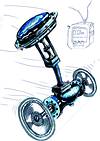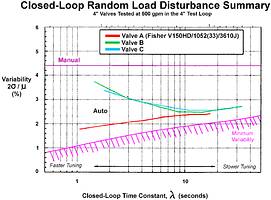

Consideration of the factors discussed in this series of articles can have a dramatic impact on the economic results of an operating plant. More and more control valve users focus on dynamic performance parameters, such as dead band, response times and installed gain (under actual process load conditions) as a means to improve process-loop performance. Although it is possible to measure many of these dynamic performance parameters in an open-loop situation, the impact these parameters have becomes clear when closed-loop performance is measured.
The closed-loop test results shown in Figure 1 demonstrate the ability of three different valves to reduce process variability over different tuning conditions. This diagram plots process variability as a percent of the set point variable versus the closed-loop time constant, which is a measure of loop tuning. The horizontal line, labelled manual, shows how much variability is inherent in the loop when no attempt is made to control it (open-loop). The line sloping downward to the left marked minimum variability represents the calculated dynamic performance of an ideal valve assembly (one with no non-linearities). All real valve assemblies should normally fall somewhere between these two conditions.

Not all valves provide the same dynamic performance even though they all theoretically meet static performance purchase specifications and are considered to be equivalent valves. Valve A in Figure 1 does a good job of following the trend of the minimum variability line over a wide range of controller tunings. This valve shows excellent dynamic performance with minimum variability. In contrast, valves B and C designs fare less well and increase in variability as the system is tuned more aggressively for decreasing closed-loop time constants.
All three valve designs are capable of controlling the process and reducing the variability, but two designs do it less well. Consider what would happen if the poorer performing valve B was replaced with the best performing, valve A, and the system was tuned to a 2,0 second closed-loop time constant.
The test data shows this would result in a 1,4% improvement in process variability. This might not seem like much, but the results over a time can be impressive. A valve that can provide this much improvement every minute of every day can amount to significant savings over a single year. By maintaining closer adherence to the set point, it is possible to achieve a reduction in raw materials by moving the set point closer to the lower specification limit. The 1,4% improvement in this example converts to a raw material saving of 45 780 litres per day. Assuming a material cost of 50 cents per litre, the best valve would contribute an additional R22 892 per day directly to profits. This adds up to an impressive R8 361 186 per year.
The excellent performance of the better valve in this example provides strong evidence that a superior control valve assembly can have a profound economic impact. This example is only one way a control valve can increase profits through tighter control. Decreased energy costs, increased throughput, less reprocessing cost for out-of-spec product and so on are all ways a good control valve can increase economic results through tighter control. While the initial cost might be higher for the best control valve, the few extra rands spent on a well-engineered control valve can dramatically increase the return on investment. Often the extra initial cost of the valve can be paid for in a matter of days.
As a result of studies such as these, the process industries have become increasingly aware that control valve assemblies play an important role in loop/unit/plant performance. They have also realised that traditional methods of specifying a valve assembly are no longer adequate to ensure the benefits of process optimisation. While important, such static performance indicators as flow capacity, leakage, materials compatibility and bench performance data are not sufficiently adequate to deal with the dynamic characteristics of process control loops.
Summary
The control valve assembly plays an extremely important role in producing the best possible performance from the control loop. Process optimisation means optimising the entire process, not just the control algorithms used in the control room equipment. The valve is called the final control element because the control valve assembly is where process control is implemented. It makes no sense to install an elaborate process control strategy and hardware instrumentation system capable of achieving 0,5% or better process control and then to implement that control strategy with a 5% or worse control valve. Audits performed on thousands of process control loops have provided strong proof that the final control element plays a significant role in achieving true process optimisation. Profitability increases when a control valve has been properly engineered for its application.
Control valves are sophisticated, high-tech products and should not be treated as a commodity. Although traditional valve specifications play an important role, valve specifications must also address real dynamic performance characteristics if true process optimisation is to be achieved. It is imperative that these specifications include such parameters as dead band, dead time, response time, etc.
Finally, process optimisation begins and ends with optimisation of the entire loop. Parts of the loop cannot be treated individually to achieve coordinated loop performance. Likewise, performance of any part of the loop cannot be evaluated in isolation. Isolated tests under non-loaded, bench-type conditions will not provide performance information that is obtained from testing the hardware under actual process conditions.
For more information contact Alpret Control Specialists, 011 249 6700, [email protected]
| Tel: | +27 11 249 6700 |
| Email: | [email protected] |
| www: | www.acs-autocon.com |
| Articles: | More information and articles about Automation Control Solutions |

© Technews Publishing (Pty) Ltd | All Rights Reserved